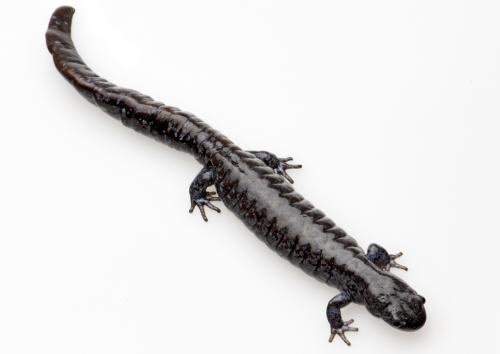
Scientific name: Ambystoma laterale
Mi’kmaq Translation: Translation Unknown
French Translation: Salamandre pointes bleus
Gaelic Translation: Teine-dhealan Spotach-gorm
Physical Description
The blue-spotted salamander is dark grey to black. They have varying numbers of pale blue spots along their sides, tail and legs. The belly is dark grey to black with blue flecks. Terrestrial juveniles are light grey to brown with smaller spots. Aquatic larvae are grey-brown with some black colour spots on the tail fin and have feathery gills behind their head and legs.
Size
Newly metamorphosized young measure 5.5 to 8.2cm in length
Adult males measure 7.8 to 13.4cm in length
Adult females measure 9.5 to 14.0cm in length
Range and Distribution
These salamanders range from southern Manitoba to the Atlantic Provinces. In Nova Scotia, they can be seen in northern regions and Cape Breton, along with a few isolated populations in both Annapolis and Queens counties. They are not typically found along the Atlantic Coast.
Habitat
Preferred habitats are deciduous and mixed forests. These areas are usually located next to aquatic breeding sites in alder swamps and slow-moving streams. Smaller habitats created by leaf litter, logs and rocks provide foraging areas and shelter.
Diet
Blue-spotted salamanders eat a variety of small invertebrates. While on land in the spring they favour slugs, insects, and earthworms. In the summer and fall they prefer snails, centipedes, earthworms and rove beetles.
Reproduction and Life Cycle
Migration to breeding wetlands happens on rainy spring nights. Females will lay up to 550 eggs in jellylike masses. These masses are attached to submerged sticks at the base of plants, stones or other vegetation under the water. Aquatic larvae hatch after a month and develop into terrestrial juveniles by the end of the summer. Sexual maturity is reached at two years old, and individuals breed only once every few years. Longevity is not confirmed but observed individuals have lived to be more than 20 years old.
Status
NSESA: Of Least Concern
COSEWIC: Not at Risk
Threats
Habitat loss, road mortality, climate change, pollution and run-off from agricultural sites are all contributing hazards for this species. While they can be fatal for individuals and population pockets, blue-spotted salamanders are abundant throughout their range and these threats pose a minimal risk for the time being.